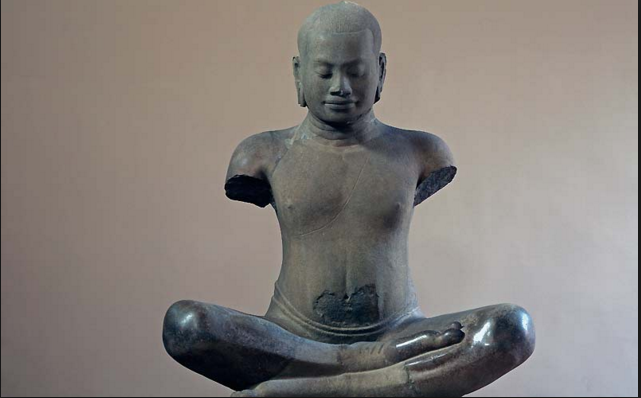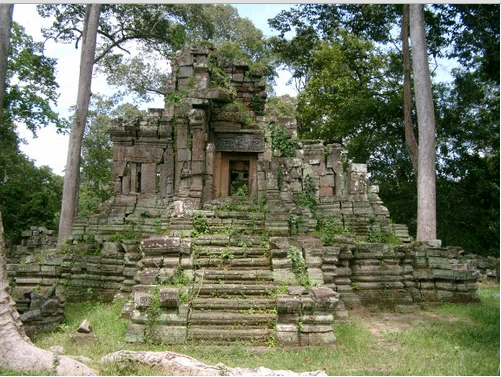Jayavarman VII was conceived around 1120 or 1125, child of King Dharanindravarman II (r. 1150 - 1160) and ruler Sri Jayarajacudamani. He wedded an extremely religious, solid minded, and commit princess, Jayarajadevi, who applied an essential impact on him, both before he picked up the throne and amid the early years of his rule.
He was a standout amongst the most strong and beneficial rulers of the Khmer Empire of Angkor. He extended the domain to its most prominent regional degree and occupied with a building program that yielded various sanctuary, expressways, rest houses, and healing facilities.
In spite of the fact that basically nothing is known of Jayavarman's adolescence and youth, it is clear that amid his late 30s and mid 40s he settled in the neighboring kingdom of Champa, in what is currently the focal area of Vietnam.
At the point when his dad kicked the bucket, his sibling or cousin - Yasovarman - seems to have guaranteed the throne, in which Jayavarman appears to disavow and to have gone on an intentional outcast to Champa. He cleared out his wife and went to Champa alone.
In 1166 Tribhuvanadityavarman, a court authority, usurped the throne of King Yasovarman. At the point when Prince Jayavarman got expression of a royal residence resistance, he hurried to come back to Cambodia - maybe to bolster King Yasovarman II or to state his own particular rights to the throne. In any case, his was past the point of no return. When he arrived, Yasovarman was at that point dead and the usurper solidly situated on the throne. Jayavarman appeared to be unwilling to endeavor to oust Tribhuvanadityavarman by power; rather he chose to stay in his country and to anticipate a chance to declare his own particular case to the throne.
Nearly 12 years after the fact, when Jayavarman was in his late 50s, that open door came as a consequence of a Cham intrusion in 1177, which realized the end of Tribhuvanadityavarman, the sacking of Angkor, and its subjection to outside guideline. In this circumstance Jayavarman sorted out a battle for autonomy and in under five years he succeeded in driving out the trespassers and setting up his administration over all his Cambodian rivals.
At long last in 1181, at 61 years old, he was delegated a sole lord of Khmer Empire and started a splendid rule of over 30 years, amid which he conveyed the domain to its peak, both as far as regional development and of imperial building design and development.
Jayavarman VII was a warrior. The best military accomplishment of his rule - maybe the best of the whole history of Cambodia - was the catch and sack of the capital of its rich and capable neighbor, Champa, in 1190. His military exercises additionally bringing southern Laos, bits of the Malay Peninsula and Burma under his control.
In any case, progressively he dedicated his energies and authoritative abilities to the sort of religious and religio-political development extends that had been carried on by his imperial antecedents. He fabricated countless new sanctuaries, including the Bayon, an unmistakably Mahayana Buddhist focal pyramid sanctuary intended to serve as the essential locus of the imperial faction furthermore as his very own catacomb; individual funerary sanctuaries of the Mahayana sort, which were devoted to his mom and dad; and a progression of common sanctuaries, which housed lessened copies of the Royal Buddha. He modified the city of Angkor Thom and revamped and amplified the arrangement of interstates, which emanated outward from the Bayon and the illustrious royal residence and came to far into the areas. What's more, he built 121 rest houses along these streets.
Amid his rule, the King constructed 102 healing centers, which he scattered all through his kingdom. Those healing facilities were inherent an endeavor to enhance states of the King's subject.
Jayavarman succeeded amid his lifetime in making a legacy that couple of rulers in Khmer history have possessed the capacity to approach. He was over 90 years of age when he passed on in around 1215.
"In 1190, King Sri Jaya Indravarman ong Vatuv made was against the King of Kambujadesa. The last sent the Prince (Vidyanandana) at the leader of the troops of the Kambuja to take Vijaya and thrashing the lord. He caught the ruler and had him led to Kambujadesa by the Kambuja troops. He declared Suryajavarmadeva Prince In, brother by marriage of the ruler of Kambujadesa, as lord of the city of Vijaya." Inscription king so as to allude to the catch of Cham city Jayavarman VII
"On the considerable courses there are spots of rest like our post transfers" Chou Ta-kuan alluding to the rest houses.
"He experienced the diseases of his subjects more than from his own; for it is people in general distress which makes the pain of lords, and not their own despondency." Inscription alluding to the healing facilities.
"religious austerity, her upright lead, her tears, her resemblance to Sita, found by her spouse and afterward isolated from him, her body diminished by observances, her religion, her dedication to him, her euphoria at this extreme return." Inscription portraying Queen Jayarajadevi after her spouse went into outcast.






















